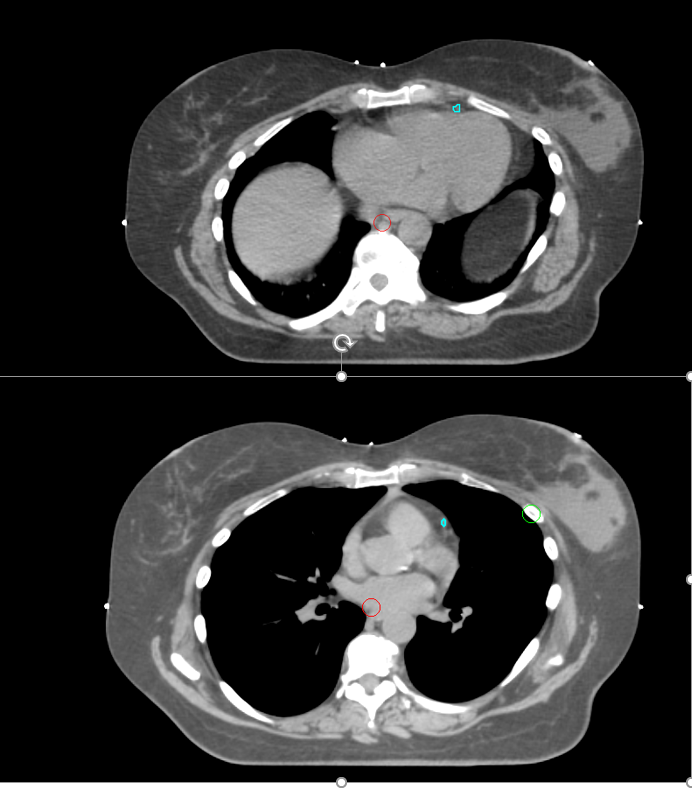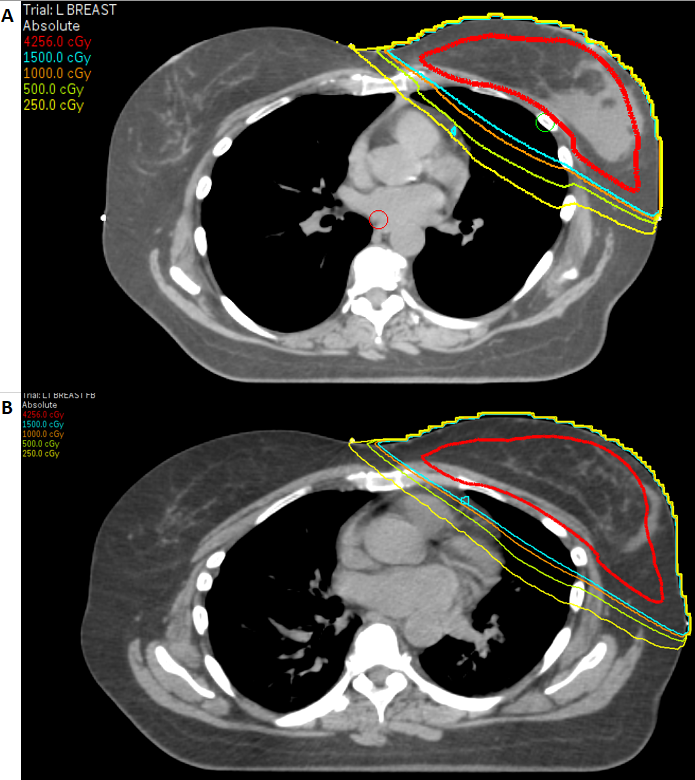[1]
Lenneman CG, Sawyer DB. Cardio-Oncology: An Update on Cardiotoxicity of Cancer-Related Treatment. Circulation research. 2016 Mar 18:118(6):1008-20. doi: 10.1161/CIRCRESAHA.115.303633. Epub
[PubMed PMID: 26987914]
[2]
Curigliano G, Cardinale D, Dent S, Criscitiello C, Aseyev O, Lenihan D, Cipolla CM. Cardiotoxicity of anticancer treatments: Epidemiology, detection, and management. CA: a cancer journal for clinicians. 2016 Jul:66(4):309-25. doi: 10.3322/caac.21341. Epub 2016 Feb 26
[PubMed PMID: 26919165]
[3]
Rygiel K. Cardiotoxic effects of radiotherapy and strategies to reduce them in patients with breast cancer: An overview. Journal of cancer research and therapeutics. 2017 Apr-Jun:13(2):186-192. doi: 10.4103/0973-1482.187303. Epub
[PubMed PMID: 28643731]
Level 3 (low-level) evidence
[4]
Niska JR, Thorpe CS, Allen SM, Daniels TB, Rule WG, Schild SE, Vargas CE, Mookadam F. Radiation and the heart: systematic review of dosimetry and cardiac endpoints. Expert review of cardiovascular therapy. 2018 Dec:16(12):931-950. doi: 10.1080/14779072.2018.1538785. Epub 2018 Nov 1
[PubMed PMID: 30360659]
Level 1 (high-level) evidence
[5]
Atkins KM, Chaunzwa TL, Lamba N, Bitterman DS, Rawal B, Bredfeldt J, Williams CL, Kozono DE, Baldini EH, Nohria A, Hoffmann U, Aerts HJWL, Mak RH. Association of Left Anterior Descending Coronary Artery Radiation Dose With Major Adverse Cardiac Events and Mortality in Patients With Non-Small Cell Lung Cancer. JAMA oncology. 2021 Feb 1:7(2):206-219. doi: 10.1001/jamaoncol.2020.6332. Epub
[PubMed PMID: 33331883]
[6]
Bergom C, Currey A, Desai N, Tai A, Strauss JB. Deep Inspiration Breath Hold: Techniques and Advantages for Cardiac Sparing During Breast Cancer Irradiation. Frontiers in oncology. 2018:8():87. doi: 10.3389/fonc.2018.00087. Epub 2018 Apr 4
[PubMed PMID: 29670854]
[7]
Halle M, Gabrielsen A, Paulsson-Berne G, Gahm C, Agardh HE, Farnebo F, Tornvall P. Sustained inflammation due to nuclear factor-kappa B activation in irradiated human arteries. Journal of the American College of Cardiology. 2010 Mar 23:55(12):1227-1236. doi: 10.1016/j.jacc.2009.10.047. Epub
[PubMed PMID: 20298930]
[8]
Hooning MJ, Aleman BM, van Rosmalen AJ, Kuenen MA, Klijn JG, van Leeuwen FE. Cause-specific mortality in long-term survivors of breast cancer: A 25-year follow-up study. International journal of radiation oncology, biology, physics. 2006 Mar 15:64(4):1081-91
[PubMed PMID: 16446057]
[9]
Orzan F, Brusca A, Gaita F, Giustetto C, Figliomeni MC, Libero L. Associated cardiac lesions in patients with radiation-induced complete heart block. International journal of cardiology. 1993 May:39(2):151-6
[PubMed PMID: 8314649]
[10]
Yeboa DN, Evans SB. Contemporary Breast Radiotherapy and Cardiac Toxicity. Seminars in radiation oncology. 2016 Jan:26(1):71-8. doi: 10.1016/j.semradonc.2015.09.003. Epub 2015 Sep 4
[PubMed PMID: 26617212]
[11]
Darby SC, Ewertz M, McGale P, Bennet AM, Blom-Goldman U, Brønnum D, Correa C, Cutter D, Gagliardi G, Gigante B, Jensen MB, Nisbet A, Peto R, Rahimi K, Taylor C, Hall P. Risk of ischemic heart disease in women after radiotherapy for breast cancer. The New England journal of medicine. 2013 Mar 14:368(11):987-98. doi: 10.1056/NEJMoa1209825. Epub
[PubMed PMID: 23484825]
[12]
Walker CM, Saldaña DA, Gladish GW, Dicks DL, Kicska G, Mitsumori LM, Reddy GP. Cardiac complications of oncologic therapy. Radiographics : a review publication of the Radiological Society of North America, Inc. 2013 Oct:33(6):1801-15. doi: 10.1148/rg.336125005. Epub
[PubMed PMID: 24108563]
[13]
Adams MJ, Lipsitz SR, Colan SD, Tarbell NJ, Treves ST, Diller L, Greenbaum N, Mauch P, Lipshultz SE. Cardiovascular status in long-term survivors of Hodgkin's disease treated with chest radiotherapy. Journal of clinical oncology : official journal of the American Society of Clinical Oncology. 2004 Aug 1:22(15):3139-48
[PubMed PMID: 15284266]
[14]
Menezes KM, Wang H, Hada M, Saganti PB. Radiation Matters of the Heart: A Mini Review. Frontiers in cardiovascular medicine. 2018:5():83. doi: 10.3389/fcvm.2018.00083. Epub 2018 Jul 9
[PubMed PMID: 30038908]
[15]
Lancellotti P, Nkomo VT, Badano LP, Bergler-Klein J, Bogaert J, Davin L, Cosyns B, Coucke P, Dulgheru R, Edvardsen T, Gaemperli O, Galderisi M, Griffin B, Heidenreich PA, Nieman K, Plana JC, Port SC, Scherrer-Crosbie M, Schwartz RG, Sebag IA, Voigt JU, Wann S, Yang PC, European Society of Cardiology Working Groups on Nuclear Cardiology and Cardiac Computed Tomography and Cardiovascular Magnetic Resonance, American Society of Nuclear Cardiology, Society for Cardiovascular Magnetic Resonance, Society of Cardiovascular Computed Tomography. Expert consensus for multi-modality imaging evaluation of cardiovascular complications of radiotherapy in adults: a report from the European Association of Cardiovascular Imaging and the American Society of Echocardiography. European heart journal. Cardiovascular Imaging. 2013 Aug:14(8):721-40. doi: 10.1093/ehjci/jet123. Epub
[PubMed PMID: 23847385]
Level 3 (low-level) evidence
[16]
Heidenreich PA, Hancock SL, Lee BK, Mariscal CS, Schnittger I. Asymptomatic cardiac disease following mediastinal irradiation. Journal of the American College of Cardiology. 2003 Aug 20:42(4):743-9
[PubMed PMID: 12932613]
[17]
Domercant J, Polin N, Jahangir E. Cardio-Oncology: A Focused Review of Anthracycline-, Human Epidermal Growth Factor Receptor 2 Inhibitor-, and Radiation-Induced Cardiotoxicity and Management. The Ochsner journal. 2016 Fall:16(3):250-6
[PubMed PMID: 27660573]
[18]
Formenti SC, Gidea-Addeo D, Goldberg JD, Roses DF, Guth A, Rosenstein BS, DeWyngaert KJ. Phase I-II trial of prone accelerated intensity modulated radiation therapy to the breast to optimally spare normal tissue. Journal of clinical oncology : official journal of the American Society of Clinical Oncology. 2007 Jun 1:25(16):2236-42
[PubMed PMID: 17470849]
[19]
Swanson T, Grills IS, Ye H, Entwistle A, Teahan M, Letts N, Yan D, Duquette J, Vicini FA. Six-year experience routinely using moderate deep inspiration breath-hold for the reduction of cardiac dose in left-sided breast irradiation for patients with early-stage or locally advanced breast cancer. American journal of clinical oncology. 2013 Feb:36(1):24-30. doi: 10.1097/COC.0b013e31823fe481. Epub
[PubMed PMID: 22270108]
[20]
Boyle J, Ackerson B, Gu L, Kelsey CR. Dosimetric advantages of intensity modulated radiation therapy in locally advanced lung cancer. Advances in radiation oncology. 2017 Jan-Mar:2(1):6-11. doi: 10.1016/j.adro.2016.12.006. Epub 2017 Jan 3
[PubMed PMID: 28740910]
Level 3 (low-level) evidence
[21]
Chun SG, Hu C, Choy H, Komaki RU, Timmerman RD, Schild SE, Bogart JA, Dobelbower MC, Bosch W, Galvin JM, Kavadi VS, Narayan S, Iyengar P, Robinson CG, Wynn RB, Raben A, Augspurger ME, MacRae RM, Paulus R, Bradley JD. Impact of Intensity-Modulated Radiation Therapy Technique for Locally Advanced Non-Small-Cell Lung Cancer: A Secondary Analysis of the NRG Oncology RTOG 0617 Randomized Clinical Trial. Journal of clinical oncology : official journal of the American Society of Clinical Oncology. 2017 Jan:35(1):56-62
[PubMed PMID: 28034064]
Level 1 (high-level) evidence
[22]
Kalapurakal JA, Gopalakrishnan M, Walterhouse DO, Rigsby CK, Rademaker A, Helenowski I, Kessel S, Morano K, Laurie F, Ulin K, Esiashvili N, Katzenstein H, Marcus K, Followill DS, Wolden SL, Mahajan A, Fitzgerald TJ. Cardiac-Sparing Whole Lung IMRT in Patients With Pediatric Tumors and Lung Metastasis: Final Report of a Prospective Multicenter Clinical Trial. International journal of radiation oncology, biology, physics. 2019 Jan 1:103(1):28-37. doi: 10.1016/j.ijrobp.2018.08.034. Epub 2018 Aug 29
[PubMed PMID: 30170102]
Level 1 (high-level) evidence
[23]
Volkova M, Russell R 3rd. Anthracycline cardiotoxicity: prevalence, pathogenesis and treatment. Current cardiology reviews. 2011 Nov:7(4):214-20
[PubMed PMID: 22758622]

